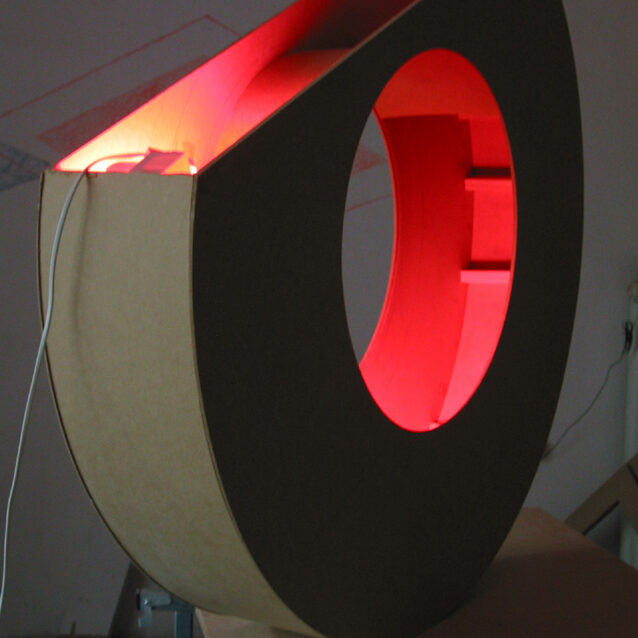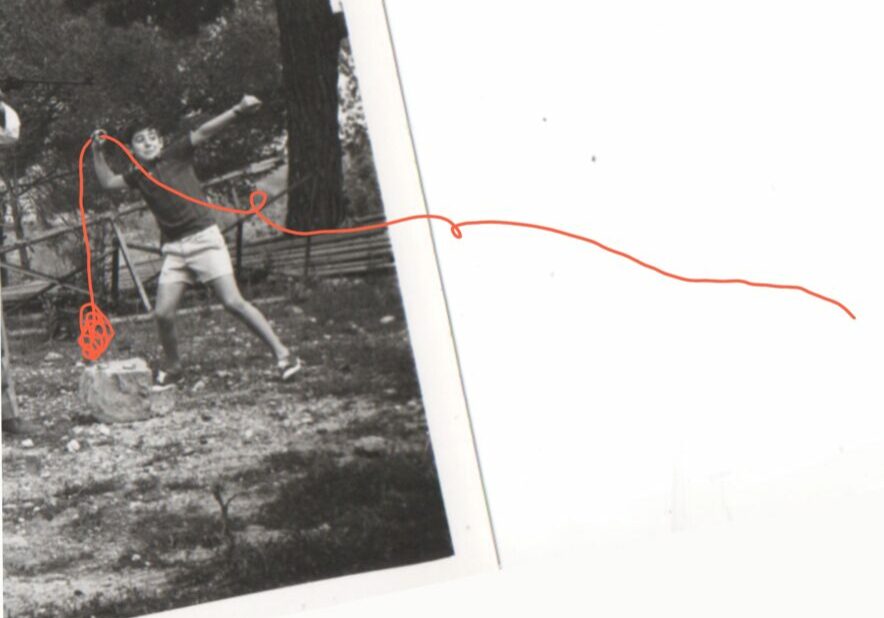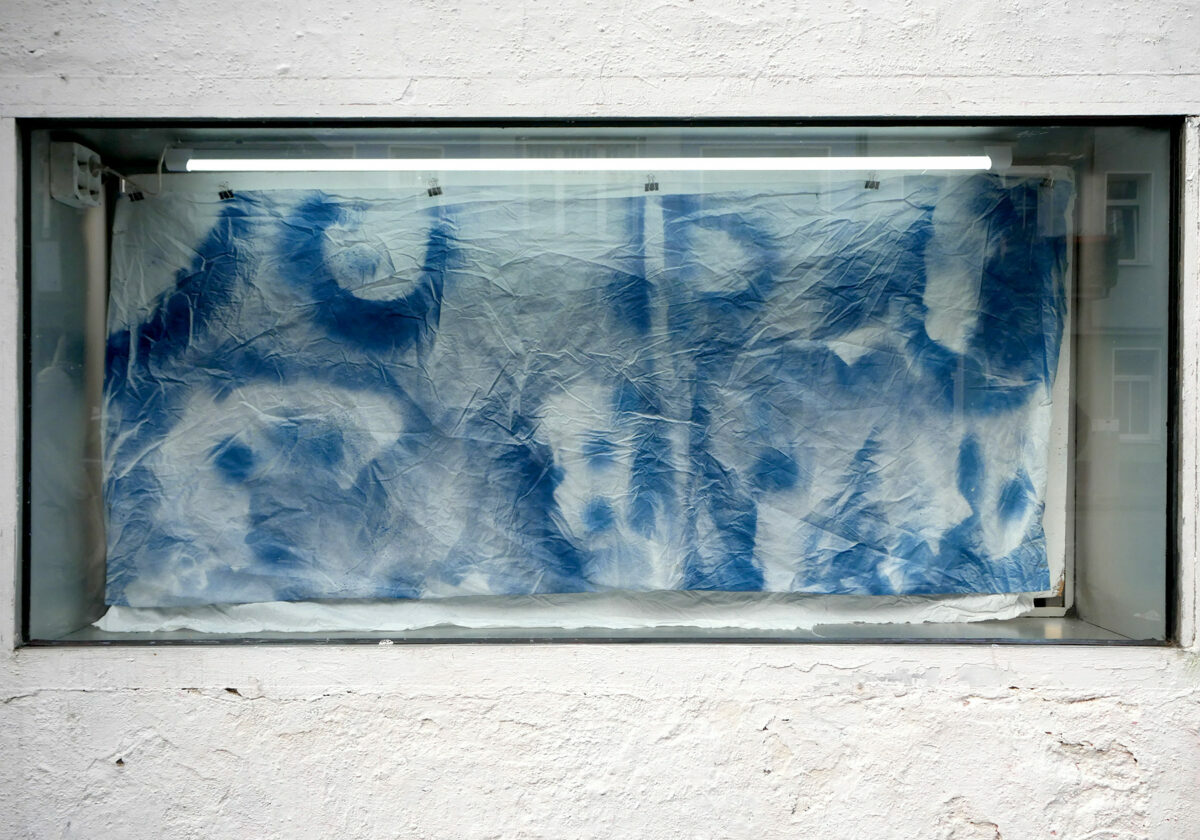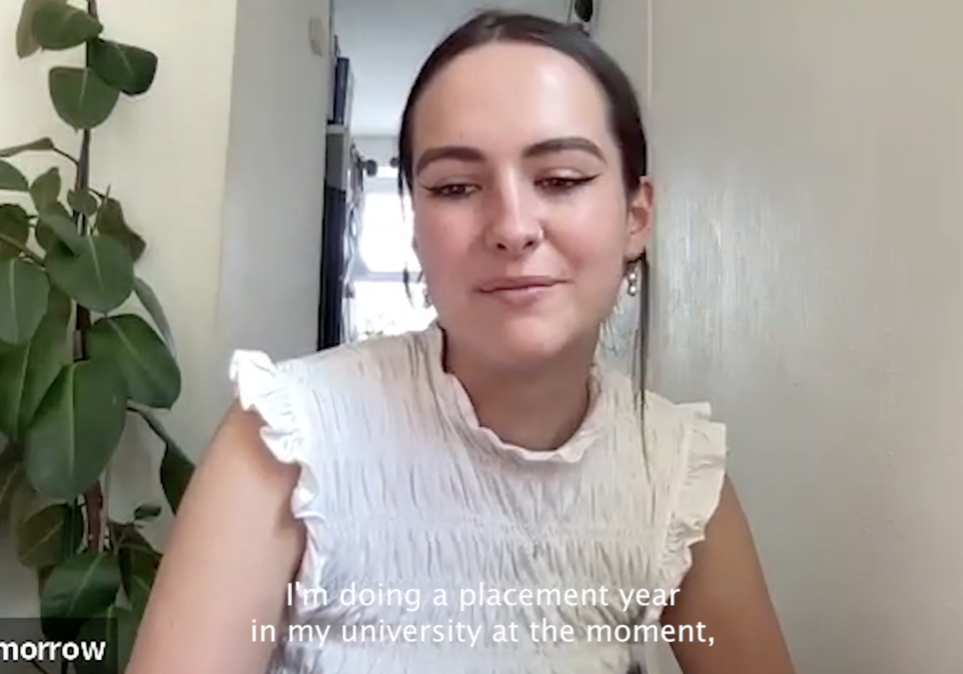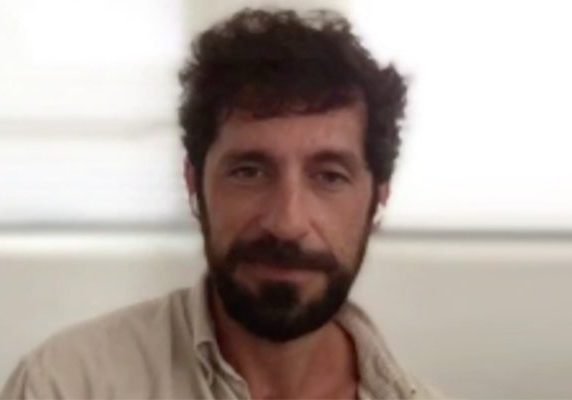Meet the on-line Artist // Carrie Stubbs
The painter and light artist based near Zurich The Zurich-based painter and artist Carrie Stubbs delves into her artistic practice and her light sculptures. In the process and methodology, we find references to art history, mentioning Josef Albers, Dan Flavin or Carlos Bunga.
This interview is the result of email correspondence between the online resident Carrie Stubbs and Laura Olea López, from the curatorial team at GlogauAIR.
Laura: Why is light central to your artistic practice? How did it start?
Carrie: I guess I have always been interested in light. I mean, employing a sort of chiaroscuro when learning to draw is really important. Often artists look at how light falls onto an object and the light and shadows are used to create the illusion of 3D on a 2D surface. In that case, without light, there is no form. Also in landscape painting, many artists have focussed on how natural light comes through trees or the light appears in the landscape.
But when the light comes from a central source, (from the object itself) it gives off a dramatic feel, almost like the feeling you have when you are in a dark church and you look towards the altar. A special sensation is achieved and that is something I am trying to capture.
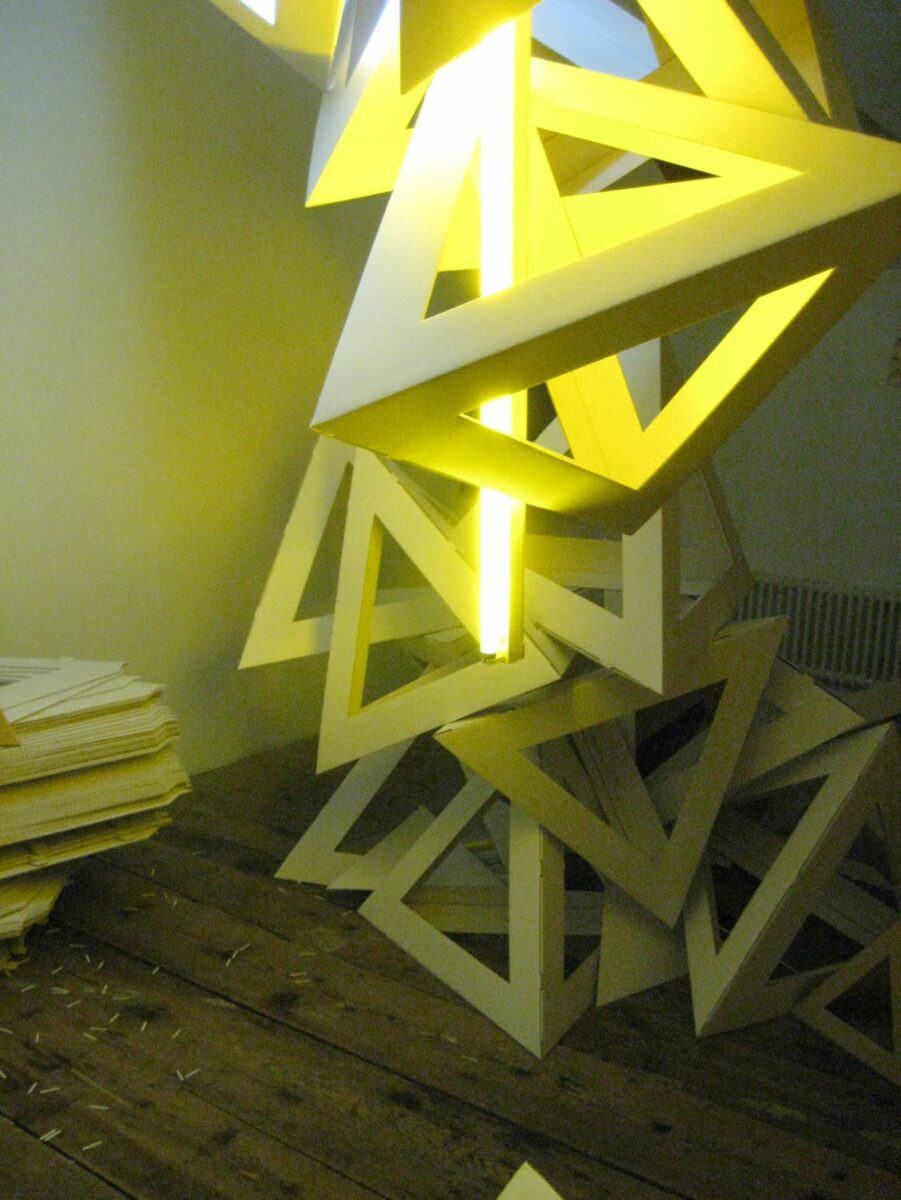
L: What conditions, information or circumstances do you have to take into account when designing or conceptualizing a new light project?
C: When thinking about an installation, I like to think about the architectural space that the piece or installation will live in and the scale of those two things to each other. Ideally, I want the work to have some sort of correspondence to the space the work will inhabit. That is not always an option, depending on the space. For that reason, I have been experimenting lately with taking my work outside and to see how it interacts within a space in the woods or in a field.
L: Are there any artists that you listen to or read about whose work or own artistic practice informs you about your work?
C: There are many artists whose work I look at and who inspire me. In addition, there are some artists who I refer to directly through appropriation; my installation ‘Die Fahne Hoch‘ is appropriated from Stella’s painting with a similar name. I often feel references to Dan Flavin as a light artist. His work is extremely present in my work and in my practice. I mean, as an artist who works with light, you can’t avoid Dan Flavin. But also the work of Eva Hesse. But also Mary Heilmann.
Currently, I have spent a lot of time looking at Carlos Bunga’s work and listening to some of his interviews. I have not yet had the opportunity to see his work in person. I have only seen videos of his installations. I find his work really inspiring and even more so, what he says about his work. One thing that stands out for me is his use of materials. Through his choice of material, his work is only temporary. He uses cardboard, which is a commercial, mundane, everyday product. He calls cardboard ‘organic’ and ‘ephemeral’. I like those ideas. By making these paintings that the viewer can enter and by withholding the stretched canvas, he does something interesting. Also, his work feels at home within immense architectural spaces (which clearly feel permanent and solid in their structure). We usually do not associate cardboard structures with permanent or exact structures. So his work has this kind of tension between these two worlds… ordered exact architecture and softer impermanent cardboard.
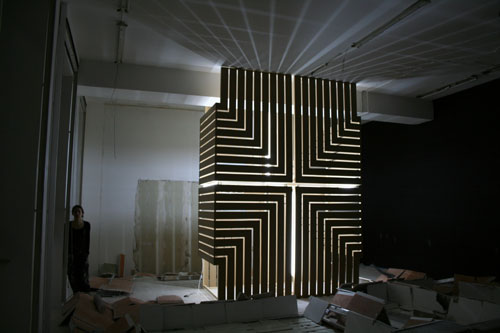
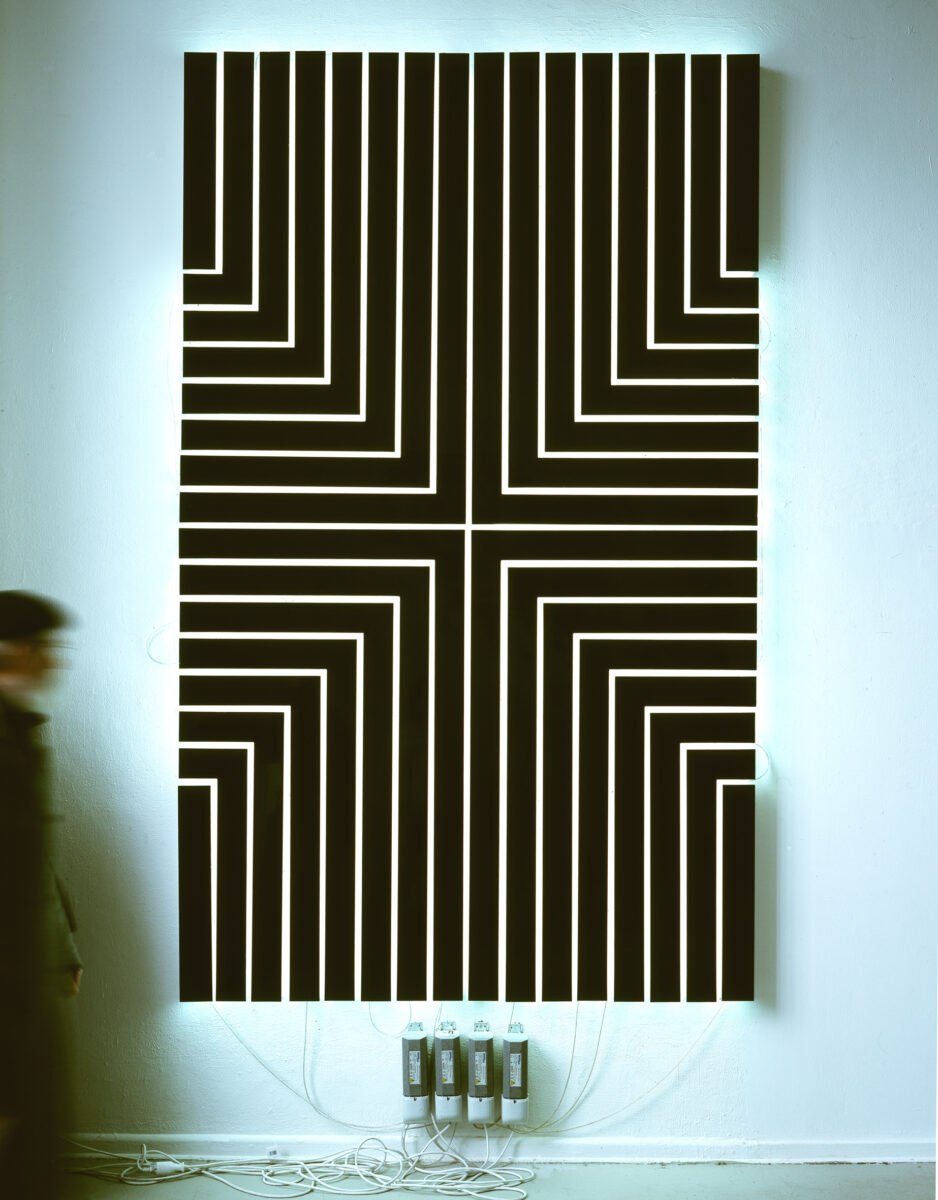
L: I think he brings up something beautiful but also very important which is the difference between image representation (connected historically with painting so it’s very hard to avoid when working on canvas) and sensation, feelings, and emotions that installations can provide to the viewer/audience. At least, working in the space and different materials leave the room to ask other things before even asking ‘what does that mean?’ as your body is inserted or overwhelmed by that artwork. The relationship (of the viewer) shifts and changes completely in the way we (the viewer) interact with his work. We reach. We connect.
I love to think about this because in your work there are two aspects present: image and sensation. Also in the creation of an image in the works that are paintings on wooden panels, there is also a connection with your installation practice: light is present in the distribution/scattering of colors, the juxtaposition of geometrical forms is the consistent presence of your work. What are the sensations, the illusions that you evoke with your work? What are the different intentions between your painting and your installations?
C: Oh that is a good question. I often think about these two practices within my body of work. The paintings for me are almost like studies. In art school, I took a typical Josef Albers color theory class and it made my head explode. I loved it. In that class, we had to do exercises that Albers developed in his book Interactions of Color. I think almost every art student has had to complete such a course. We had to use ‘COLOR/AID Sets of Color Swatches‘ (boxes of 314 velvety-printed pieces of colored paper) to complete these tasks. For example, we had to make 2 small squares of the same color look like two different colors. Such exercises taught me how similar and different color can look and feel based on its surroundings, its temperature, based on everything. It made me curious. Light does the same thing. Light has a temperature and a color. It has a huge effect on how we perceive our world and it fascinates me. I think in both my installations and in my paintings, that need of exploration is what connects these two practices.
When talking about his installations, Bunga said that his work invites the public to be or go inside. For him, this interaction activates the pieces and he thinks that the public has a different sensation, a subjective and personal one from that experience. I think that is something that I also hope for in my work – especially when working with light.
L: In reference to Josef Albers: your paintings are geometrical explorations of layers of solid colour and in a certain sense, similar to the approach of Albers in his series ‘Homage to the Square‘. Do you see your process as being similar to Alber’s work? and if so, how? And, how is the process you use in your paintings parallel to the planning and design of the light sculptures and installations?
C: I do see the similarities between my process and that of Albers’. Albers’ ‘Homage to the Square’ series are color studies. He had a given system, a set of rules about the format that he stuck to. He used that system to explore how different colors worked together. My painting process is not as rigid as Alber’s was, but my paintings all do have a similar format (size and shape of canvas). However, they are much more about the exploration of how color moves forward away from the surface and back within the picture frame. While painting them, the process is not as set in stone. In other words, I react much more to what I see and they develop as I go. I have not planned the entire composition before I start a painting. This is quite a different process compared to the installation and light sculpture. For installations, I usually plan out many elements of how the piece will be made and where it will be placed before starting to create it. So, these pieces are much more conceptual in the creation-process than the paintings.

L: In an interview in 2012, Lucy R. Lippard recounts that she had always been interested in the word and the image, but that her efforts always fell somewhere in between and “you knew you could never get it” I think what she is talking about is that there is this gap between the spoken/ written word and the image, or the experience of that artwork. I also find it a struggle to approach, describe or talk about some specific artworks that I feel you have to experience the piece. In this case, I would say your light sculptures and installations – that I have never seen in real life – could also be challenging to describe. Could you describe your visual work to someone that didn’t experience your installations or seen any pictures?
C: I agree with you and with Lucy Lippard; at times words, and language does not do the work justice. For my work, I think the challenge lies in the essence of the piece I am trying to create. I have always been drawn to other people’s artwork that has some sort of aura (for lack of a better word). If I think back to work that has made some sort of impression on me in my development as an artist, I always think back to pieces where the experience or the sensation of seeing those pieces was visceral. For example, the first time I saw Donald Judd’s copper cube called ‘Untitled’ from 1972 with its shiny, reflective surface. When peering inside that sculpture, it felt like it was lit from within, as if it was standing by a perfectly minimalist campfire of warmth. It made a huge impression on me. It’s nearly impossible to explain such a sensation. You have to experience it. It’s something that I think I try to achieve in my own installations.
L: What is the relationship you would like the audience to have with your work? How do you imagine the interaction between the artwork and the public?
C: Hmm, I think that when working with light, the audience automatically interacts with it. I mean, when someone enters the space, the light goes beyond the boundaries of the work itself and is cast throughout the room. The audience has to interact with it. Their presence automatically impacts that installation.
This goes back to what Carlos Bunga said so eloquently about his installations – that it invites the audience to interact with it, making their experience of the work much more subjective and personal.

L: Would you describe and associate your work with minimalistic references? in terms of art history and also for the forms and shapes you choose?
C: Definitely. I think of my work as being part of a post-minimalist discourse. The minimalists often created this ‘Reduced Perfection’- which is interesting because my work is anything but perfectionist. Often my choice of materials is a bit at odds with these references to the minimalists’ work, as is the final execution of the work itself.
Another one of my all-time favorite artists is Eva Hesse. She also often gets compartmentalized into the minimalist genre. For me, I am so interested in how her repetitions of geometries and material become almost organic.
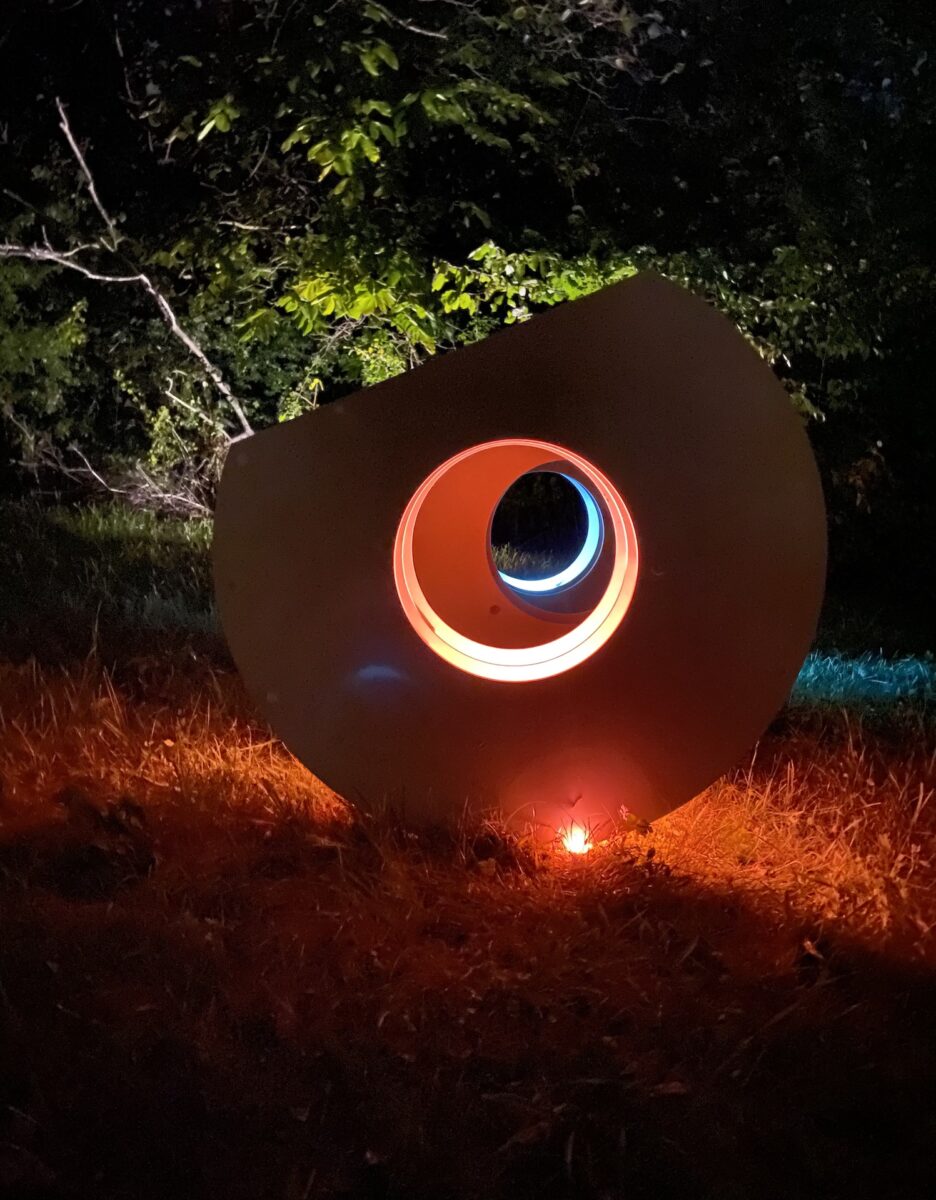
L: What are you working on next in this second term as an online resident at GlogauAIR?
C: There are two projects that I am working on. One is an installation involving large frames. The other is a series of paintings that have a topographic surface structure.
The new project by Carrie Stubbs will be part of Virtual Open Studios from December 16th and 17th 2022 on www.glogauAIR.net

